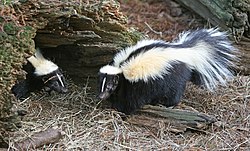| Subspecies | Skin | Skull | Trinomial authority | Description | Range | Synonyms |
|---|
Canada skunk
M. m. mephitis(Nominate subspecies) | |  | Schreber, 1776 | A large subspecies with a short and slender tail and a mixed black and white coat with constant markings. [9] | Eastern Canada; Nova Scotia, Quebec, and northern Ontario. | M. americana (Desmarest, 1818), chinche (Fischer, 1829), mephitica (Saw, 1792), vulgaris (F. Cuvier, 1842) |
Illinois skunk
M. m. avia | | | Bangs, 1898 | Similar to M. m. mesomelas, but with a slightly larger skull. [9] | Prairie region of Illinois, western Indiana, and eastern Iowa. | newtonensis Brown, 1908
|
Florida skunk
M. m. elongata | | | Bangs, 1895 | A medium-sized subspecies with a very long tail. The white markings are usually very broad. [9] | Florida to North Carolina, and in the mountains to West Virginia; west on the Gulf coast to the Mississippi River. | |
Arizona skunk
M. m. estor | |  | Merriam, 1890 | A small subspecies resembling M. m. varians, but with a shorter tail and smaller skull. The white markings are particularly broad along the back and tail. [9] | Arizona, western New Mexico, Sonora, Chihuahua, and northern Lower California; south in the Sierra Madre to southern Chihuahua. | |
Southern California skunk
M. m. holzneri | | | Mearns, 1898 | Similar to M. m. occidentalis, but smaller. [9] | Southern California, from vicinity of Monterey Bay south into Lower California; east to the Sierra Nevada and San Bernardino Range. | |
Northern plains skunk
M. m. hudsonica | |  | Richardson, 1829 | A very large subspecies with a heavily furred, medium-sized tail. [9] | Western Canada, from Manitoba to British Columbia; south in the United States to Colorado, Nebraska, and Minnesota. | americana (Lesson, 1865), chinga (Tiedemann, 1808), minnesotoe (Brass, 1911) |
Great Basin skunk
M. m. major | | | Howell, 1901 | Probably the largest subspecies, similar to M. m. occidentalis, but with longer hind feet and a heavier skull. [9] | Eastern Oregon, northern California, and Nevada; east to the Wasatch Mountains in Utah. | |
Louisiana skunk
M. m. mesomelas | |  | Lichtenstein, 1832 | A very small, short-tailed subspecies. [9] | West side of Mississippi Valley from southern Louisiana to Missouri; westward along the coast of Texas to Matagorda Island; and up the Red River Valley as far at least as Wichita Falls. | mesomeles (Gerrard, 1862), scrutator (Bangs, 1896) |
Eastern skunk
M. m. nigra | |  | Peale and Palisot de Beauvois, 1796 | A medium-sized subspecies, with a longer tail than that of M. m. mephitis. [9] | New England and Middle Atlantic States; south to Virginia; west to Indiana. | bivirgata (C. E. H. Smith, 1839), dentata (Brass, 1911), fetidissima (Boitard, 1842), frontata (Coues, 1875), olida (Boitard, 1842), putida (Boitard, 1842) |
Cascade Mountains skunk
M. m. notata | | | Hall, 1936 | Similar to M. m. occidentalis, but with a shorter tail, heavier skull, and narrower stripes. [9] | Southern Washington and northern Oregon, east of the Cascade Mountains. | |
California skunk
M. m. occidentalis | |  | Baird, 1858 | A large subspecies resembling M. m. hudsonica, but with a longer tail and narrower skull. [9] | Northern and central California, from the vicinity of Monterey Bay northward, west of the Sierra and Cascades, to the Willamette Valley, Oregon. | notata (Howell, 1901), platyrhina (Howell, 1901) |
Puget Sound skunk
M. m. spissigrada | | | Bangs, 1898 | Similar to M. m. occidentalis, but with a shorter tail and more white on the body and tail. [9] | Shores of Puget Sound and coastal region of Washington and northern Oregon. | foetulenta (Elliot, 1899) |
Texas long-tailed skunk
M. m. varians | | | Gray, 1837 | A large, very long-tailed subspecies whose markings closely approach those of M. m. hudsonica. [9] | Southern and western Texas, eastern New Mexico, and adjacent parts of Mexico; north into Oklahoma, Colorado, Kansas, and Nebraska. | texana (Low, 1879) |
|













